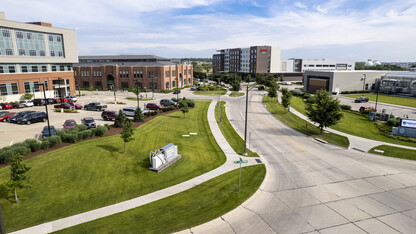· 4 min read
Researchers land EPA grant to study school environments

Most U.S. children spend the biggest portions of their days at home or in school.
While much is known about the impact of home environments on childhood development, little data exists about how the country’s school buildings affect the academic development of children.
A UNL team led by faculty from the Durham School of Architectural Engineering and Construction and the College of Education and Human Sciences has earned a $998,433 grant from the U.S. Environmental Protection Agency’s Healthy Schools initiative. The four-year study will examine indoor environmental factors and their effects on the scholastic achievement of K-12 students. It is one of seven EPA grants totaling about $6 million funded through the initiative.
Lily Wang, professor of architectural engineering and the College of Engineering’s associate dean for graduate programs and faculty development, has studied how school acoustics affect elementary student achievement. The initiative provides an opportunity to expand that work.
“I had long been thinking that there are people down the hall from me who are doing lighting studies and thermal and indoor air-quality studies. Wouldn’t it be great if we could do an integrated investigation where we survey all of these aspects of the indoor environment … correlating the assorted building conditions to actual student performance outcomes?” Wang said. “The topic is such a good fit for our research group because it pulls on our combined strengths at the Durham School, where we have expertise in all of these core disciplines.”
The research staff on the grant includes Durham professor Clarence Waters (with expertise in lighting and power distribution systems) and assistant professor Josephine Lau (with expertise in building mechanical systems, particularly thermal conditions and indoor air quality). Lau previously had carried out projects in different school districts by using EPA Indoor Air Quality Tools for Schools. She also studied schools’ indoor air quality with a research project focused on bio-aerosols monitoring with and without air-cleaners in elementary classrooms and their relationships to students’ absenteeism.
The grant is housed within the Nebraska Center for Research on Children, Youth, Family and Schools. Jim Bovaird, associate professor of educational psychology, brings his experience in designing experiments for school-based settings and in analyzing the data.
“The Durham School faculty members provide the technical expertise for the research, but having Dr. Bovaird on the team is really the key,” Wang said. “He will be instrumental in applying more sophisticated data analyses to the data we collect, so that we can investigate how these environmental conditions interact with each other. Which environmental variables have greater impact? How do these effects vary with different student demographic groups? There’s a lot of statistics involved to get at these answers.”
Statistical analyses will be key in the study’s first year, which Wang said will mostly focus on examining public database information on student achievement in California. That data will be connected to information gathered through the state’s High Performance Incentive Grant program, which funded new, environmentally friendly school building construction and renovations of existing buildings over the past decade. The UNL group hopes to find patterns that could help in preparing for a study of schools in four cities.
In years two and three, public school districts in Lincoln, Papillion-La Vista, Gretna and Council Bluffs, Iowa, will allow the researchers to monitor classroom environments and will provide student achievement data. Wang said the final year would include determining what the group learned. As part of a community engagement plan, Nebraska-based architecture and engineering firm DLR Group will consider how it can implement the findings in school building and renovation.
Wang said the results could make a big difference in schools.
“We expect this to be a really high-impact project,” she said. “In an era when the hot topics in engineering are typically related to nanotechnology or biomedical engineering, we’re thrilled that the EPA is actually funding work on the indoor environments that we’re staying in every day and how that impacts our children.”







